Text/Yangcheng Evening News All-Media Reporter Lu Nanfang Photo/Yangcheng Evening News All-Media Reporter Deng Bo
In the late Qing Dynasty, Ci KomiksCinema overhauled the Summer Palace and recruited skilled craftsmen across the country. Li Wenyuan, a craftsman from Shawan Town, Panyu, Guangzhou, came to Beijing to take the exam, but he did not expect to win the top murals in one fell swoop. From then on, he worked in the inner court to wait for the orders of the emperor.
In 2016, He Shiliang, a villager and brick carving artist of Li Wenyuan, won the highest award in Chinese folk art – the Mountain Flower Award with his craftsmanship that is as skilled as his predecessors. In July 2022, the Central General Library of the National Edition Museum, known as the “Chinese Cultural Seed Gene Bank”, unveiled the mystery, including He Shiliang’s works.
From Li Wenyuan to He Shiliang, Lingnan architectural culture has gone from being partial to entering the hall and entering the room, and the text is passed down from generation to generation, and the text is continuous. Tracing their common origin, Shawan, Panyu, is an ancient cultural town with a long history in Lingnan. The surnames Li and He are both big surnames in Shawan Town. Most of their ancestors were officials and nobles, and they moved here one after another to avoid military chaos in the late Southern Song Dynasty. Because of his wealth, Shawan people built civil engineering and valued culture and education. To this day, the town has engraved the marks of history and civilization everywhere, and the legend of hiding dragons and lying tigers is even more talked about.
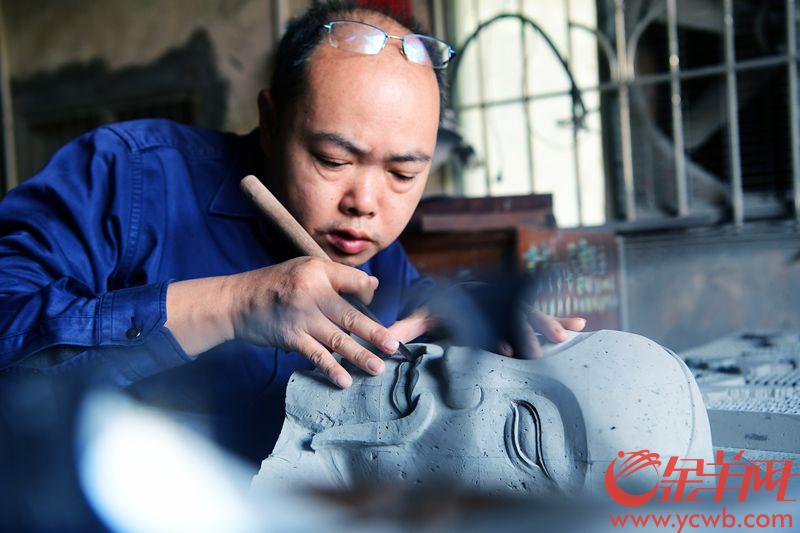 He Shiliang
He Shiliang
He Shiliang is 52 years old this year, and is born, grown up and life in Shawan. Walking on the old street of the ancient town, the old man under the banyan tree greeted him warmly – “Master He”, but he looked shy and never said a few words of scenes. Although he has long been a celebrity in Shawan, he never regards himself as a “Master Komiks”. In his opinion, he was just immersed in the “ancient style and rain” of Shawan since childhood, and it was a fate to be connected with ancient buildings.
Starting from bricks, He Shiliang was addicted to carving beams and paintings of roads and building Lingnan. People may not believe it when they say it. As the first traditional architectural craftsman in Guangdong and the “brick carving craftsman” in the country, he learned brick carving skills almost entirely by himself. Like many folk art geniuses, he has a low education and can learn without a teacher. In the past ten years, the concept of intangible cultural heritage has been deeply rooted in people’s hearts.As the inheritor, He Shiliang devoted a lot of his energy to “passing on the hiring and helping”. He hopes to work with his apprentices to work hard and through the integration and innovation of traditional art and modern aesthetics, the art of brick carving will move from the scenic spot exhibition hall to ordinary life, and from the ancient city of Lingnan to a broader world stage.
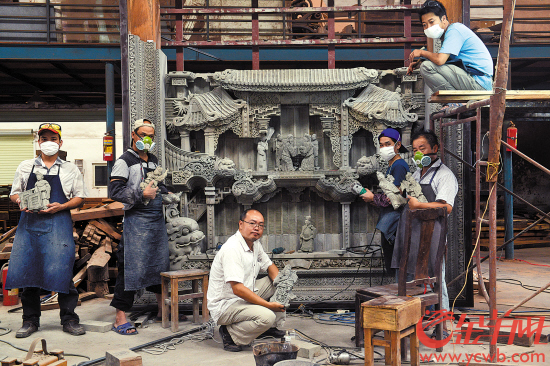 In 2015, He Shiliang (third from left) created the stage brick carving wall “The Six Kingdoms Grand Priest” for the Guangdong Cantonese Opera Museum, and won the China Folk Literature and Art Mountain Flower Award.
In 2015, He Shiliang (third from left) created the stage brick carving wall “The Six Kingdoms Grand Priest” for the Guangdong Cantonese Opera Museum, and won the China Folk Literature and Art Mountain Flower Award.
Strange Man: From an apprentice in the furniture factory to a famous brick carving craftsman
Shawan Ancient Town has a history of more than 800 years. It still preserves many “living specimens” of Lingnan traditional culture, including Guangdong music, puffing colors, fish lanterns, ancient ancestral halls, etc., which makes Shawan a veritable national-level folk art hometown.
Scraping out various patterns with a knife on a blue brick was just a kind of entertainment to He Shiliang when he was a child. Where He Shiliang was born, there were brick carvings left on the old houses and ancestral halls. At that time, he only thought it was ordinary, and He Shiliang did not wish to use this as his career for these “small tricks of carving and insects”. In comparison, he loved painting more.
It was not until he graduated from junior high school that he entered a furniture factory as an apprentice. He was fascinated by the wood carving techniques of his master and master, so he didn’t sleep in the middle of the night and secretly took out white paper to copy their design drawings. When the master, who was in his seventies, not only did not blame him, but instead developed a love for talent. He taught He Shiliang to carve and draw step by step, as if he regarded him as his successor.
The master Hu Zhi was born as a master of Lingnan Wood Carving Factory. After retirement, he continued to engage in wood carving design. He was a “big name” in the Cantonese furniture wood carving industry in the 1990s. Master Hu Minqiang is the son of his master. He received the true teachings of his master and had a profound attainment in furniture and wood carving. The experience of learning wood carving with his master and his master changed He Shiliang’s lifelong destiny.
In 1996, he had the opportunity to participate in the reconstruction of Baomo Garden in Panyu and undertake the task of wood carving. The project commander-in-chief wanted to make a large brick carving screen wall. He took a fancy to He Shiliang’s carving skills and forced him to change from wood carving to brick carving – you should know that He Shiliang had never touched brick carving at this time. With the spirit of a newborn calf not afraid of a tiger, He Shiliang spent three years to complete the artistic brick carving “Tu Yan He Ming Wall” which is 22.35 meters long and 5.83 meters high. This brick carving combines techniques such as round carving, openwork, relief and line carving. Its overall momentum is magnificent, and the meticulous craftsmanship breaks through the traditional expression handBabaylan method set a precedent for the display of single brick carving artworks and was selected as the best record in the Shanghai world’s Guinness at that time.
For a time, He Shiliang became famous. The three “literary” ornaments of traditional Chinese architecture, wood carving, brick carving and stone carving, He Shiliang was proficient in two. In 2001, he founded a crafts studio with brick carving as the theme. To outsiders, this is a thankless choice. With He Shiliang’s craftsmanship and fame, if he opens a wood carving furniture factory, he can get rich quickly. But what He Shiliang thought was that Lingnan brick carving was on the verge of losing, and he must carry forward this traditional and exquisite craftsmanship again.
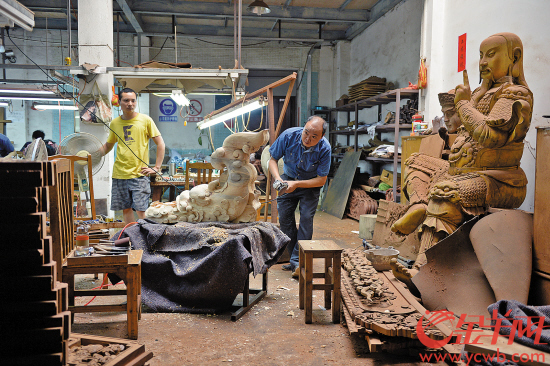 He Shiliang (right)’s studio in Shawan Town
He Shiliang (right)’s studio in Shawan Town
Talent: From Lingnan brick carvings to Lingnan architecture
The history of Lingnan brick carvings can be traced back to the Western Han Dynasty and the Nanyue Kingdom period. A brick walkway was unearthed in the ruins of the palace of the Nanyue Palace Garden of the Western Han Dynasty at the Fourth Road of Zhongshan, Guangzhou, which was excavated in the 1990s, with geometric patterns and small seal characters engraved on the floor tiles. Some brick carvings painted in vermilion or green and brick carving window lattices were also discovered one after another. By the Ming and Qing dynasties, brick carvings had been widely used in ancestral halls, temples and houses in Lingnan, forming a unique style.
However, He Shiliang’s love for brick carving art was not only because it is an “antique”. On the contrary, he liked the atmosphere of life exuding from Lingnan brick carvings, which was daily, friendly and full of vitality. “Lingnan brick carvings and other placesCinema are different and have a very unique charm. If the northern brick carvings are bold and the Jiangnan brick carvings are elegant, the Lingnan brick carvings are exquisite in the roughness, and they are more civilian and fireworks in the choice of subject matter. ”
In the brick carvings created by He Shiliang, Lingnan scenery such as lychee, banana, Buddha’s hand, red cotton, lotus, etc. are common elements, and the characteristics of South Guangdong are vividly revealed. These objects have deeper meanings. For example, lychee is homophonic to Cantonese pronounce “Laizi” and Buddha’s hand is homophonic to Cantonese pronounce “Fu Shou”. This is the Lingnan culture code hidden in brick carvings, and only locals can understand it.
 The Lingnan scenery in He Shiliang’s brick carvings, the picture shows Dongguan Yuehui GardenKomiks Part of “Hundred Bats and Spring”
The Lingnan scenery in He Shiliang’s brick carvings, the picture shows Dongguan Yuehui GardenKomiks Part of “Hundred Bats and Spring”
Because of the unique folk atmosphere of Lingnan brick carvings, He Shiliang’s ideal brick carving art is not an exhibit placed in a museum or scenic spot, but an art that is truly integrated into the architectural pattern of Lingnan, and is both functional and decorative.
“The characteristics of Lingnan brick carvings in each era are different, but their development is in line with the development of Lingnan architecture. For example, Liugeng Hall in Shawan Town is a typical Qing Dynasty ancient building. It uses brick carvings and brackets to replace the wooden components of the past, which is more functional and has a more simple and extensive style. But when you arrive at the Chen Family Ancestral Hall, you will find that the characteristics and uses of brick carvings are completely different, the techniques are more complex, the subject matter is richer, and the decorativeness overshadows the functionality.” He Shiliang was very excited when talking about the combination of Lingnan brick carvings and Lingnan ancient buildings. However, the “History of Weishui” of brick carvings is coming to an end in modern times. Later, the popular architectural types of arcades and small villas in Guangzhou gradually replaced traditional buildings, and brick carvings were difficult to find a place to use in construction projects.
Until recent years, Lingnan brick carvings have attracted more and more attention as an intangible cultural heritage, and He Shiliang was able to participate in the collective creation of some urban landmark buildings. In 2015, He Shiliang created the stage brick carving wall “The Six Kingdoms’ Grand Priest” for the Guangdong Cantonese Opera Museum. His work restored the lively scenes and rich character shapes in the same title. He fully demonstrated the traditional Lingnan brick carving craftsmanship and won the 12th China Folk Literature and Art Mountain Flower Award Art Works Award.
From brick carving as the starting point, He Shiliang spent a lot of effort to study ancient buildings in Lingnan and was committed to exploring and inheriting Lingnan architectural culture from all aspects. He did not stop working as a “driller”, and he has achieved great success in building space design, component building, decoration and decoration. In 2022, he produced 200 Manchurian flower windows with Lingnan characteristics for Wenhan Pavilion, the Central General Pavilion of the National Edition Museum, and customized two VIP rooms with Lingnan culture for the Guangzhou Branch. “I cherish the job opportunities like Cinema very much, so that more people can feel the charm of Lingnan architecture without going to the Chen Family Ancestral Hall or Liugeng Hall. I hope our contemporary city is BabaylanThe city’s landmark buildings can have more boutique projects that integrate traditional architectural culture, spirit and skills, leading my country’s contemporary architectural design to a higher and richer artistic level. ”
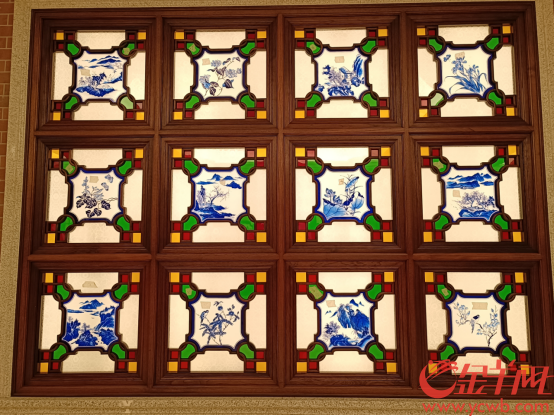 He Shiliang made Manchurian Flower Window for the Central General Pavilion of the National Edition Pavilion
He Shiliang made Manchurian Flower Window for the Central General Pavilion of the National Edition Pavilion
Qizhi: From the national to the world
In 2008, Lingnan brick carvings were listed as Guangdong’s provincial intangible cultural heritage. He Shiliang was in a complicated mood at the beginning of the identity of the inheritor of intangible cultural heritage. He was worried that the positioning of intangible cultural heritage means announcing that brick carvings are inevitably becoming “antiques”, which is what he least wants to face.
So, with the studio as a base, He Shiliang began to recruit apprentices everywhere. In order to support himself and his apprentices, He Shiliang opened a factory, inheriting the Recruiting some commercial projects of brick carving and wood carving to “transfusion” for him in the Lingnan brick carving process.
Ding Junyun began to learn carving from scratch with He Shiliang since 2004, and participated in the carving of “Hundred Bats and Huichun” in Dongguan Yuehui Garden. “Hundred Bats and Huichun” is another masterpiece of brick carving created by He Shiliang after “Tu Yan and Mingbi”. It is about 50 meters long and 9 meters high. It took nearly three years from design, production, installation to completion. Ding Junyun recalled that in those three years, he went out early and returned late with his master almost every day, and accompanied them with the harsh sound of electric drills. href=”https://funnybookish.com/”>Babaylan, dull carving sound, Babaylan and the dust that hit the nose.
In the view of Ding Junyun, who was less than 20 years old at the time, brick carving was a hard and boring job. He chose to follow He Shiliang as an apprentice just to make a living. Until the whole work was completed, Ding Junyun was deeply shocked. He took a photo of the work to his hometown in rural Guangxi to see, and no one believed it was his masterpiece.
“I didn’t have the confidence to learn brick carving at the beginning. It was the master who encouraged me to be patient and to think more. Gradually, I fell in love with this art and hoped that more people would understand brick carving. “Ding Junyun is now the most enthusiastic among all He Shiliang’s apprentices. Babaylan and public publicity. He often goes to schools and communities to show and explain brick carving skills. In 2018, he was named the district-level intangible cultural heritage of the Guangzhou brick carving project.
Cinema://news.ycwb.com/pic/2022-10/04/3da1e522-e53e-4293-9d12-2016cda684be.png” />The working environment for brick carving is very difficult
He Shiliang often advises his disciples to read more books and watch more exhibitions. He hopes that his disciples will not only position himself as a traditional architectural craftsman, but to study brick carving as an art. He wants to change people’s stereotypes about intangible cultural heritage-not just pursuing retro and conservativeness, but to creatively develop traditional art and truly build people’s confidence and pride in their aesthetic traditions.
In He Shiliang’s view, aesthetics are more important than techniques. A brick becomes a brickCinema carving artworks must go through multiple processes such as drafting, roughing, fixing, polishing, and installation. It not only requires craftsmen to have a foundation in painting design, but also have an accurate grasp of three-dimensional depth. In addition, the creation of traditional brick carving themes requires a very solid knowledge reserve for local culture, folk history, ancient novels and operas. In order to “make up lessons”, He Shiliang once collected books on Lingnan literature and history everywhere. Because brick carving likes to use flowers, birds and beasts, he repeatedly studied “Hundred Birds”, “Hundred Beasts”, and “Hundred Flowers”. He even studied photography by his disciples, spending a long time visiting ancient buildings in various parts of the Pearl River Delta every year. After returning home, he washed out the photos and studied them one by one with a magnifying glass to learn from others’ strengths.
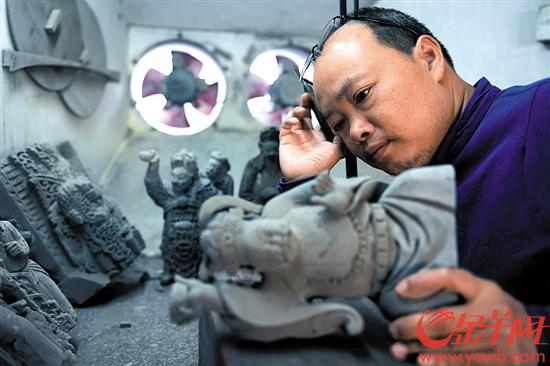 He Shiliang has a tenacity in his brick carving factory. He has to learn everything to the extreme. Although he often doesn’t say anything, what he makes is always unexpected and extraordinary. “Yangcheng Evening News reporter Deng Bo and He Shiliang met in an interview more than 20 years ago. His first impression of He Shiliang was that he was “unsatisfactory”. After getting familiar with him, Deng Bo realized that the shining points of He Shiliang were not easy to see in artistic geniuses.
He Shiliang has a tenacity in his brick carving factory. He has to learn everything to the extreme. Although he often doesn’t say anything, what he makes is always unexpected and extraordinary. “Yangcheng Evening News reporter Deng Bo and He Shiliang met in an interview more than 20 years ago. His first impression of He Shiliang was that he was “unsatisfactory”. After getting familiar with him, Deng Bo realized that the shining points of He Shiliang were not easy to see in artistic geniuses.
Archivist Wang Enhan also met He Shiliang because of interviews. He has visited famous brick carvings all over the country, but there are almost very few people like He Shiliang who can surpass his predecessors in craftsmanship and techniques, and at the same time grasp the grand theme creation. “The magic of folk art lies in the artistsIn itself, many of his achievements are created by personal talent. This is difficult to replicate and also leads to the extinction of folk art. ”
However, He Shiliang himself is not so pessimistic. Despite the bleak benefits, he has been working diligently in running studios and factories for decades. In 2020, he also built the He Shiliang Art Museum in the central square of Shawan Ancient Town, which displays more than 50 brick carvings and wood carvings, all of which are his ingenious work. In 2021, the screen wall brick carving “Ancient Rhymes and Tengwu·Present Times” he created for Shawan Town was born and became another new architectural landmark in the ancient town. “Does the tradition Babaylan must be behind the times? I never think so. There is a saying that goes, the more national it is, the more world it is. Lingnan architecture is full of treasures, and it should be seen by more people. ”
 In 2021, He Shiliang created a large-scale screen wall brick carving for Shawan Ancient Town “Ancient Rhymes and Tengfang·Present Times”
In 2021, He Shiliang created a large-scale screen wall brick carving for Shawan Ancient Town “Ancient Rhymes and Tengfang·Present Times”
Dialogue with He Shiliang
Yangcheng Evening News: What steps do you need to go through from a blue brick to a brick carving work?
He Shiliang: The process of brick carving is divided into material selection, cutting, blotting, grouping, polishing, installation, whole, cleaning, etc. Cutting is to cut off the blank layer on the surface of the old blue bricks to form bricks with equal size and square angles. The draft is designed and constructed according to the size of the work, the theme of expression, etc. href=”https://funnybookish.com/”>Komiks drawings. Blanking is based on the line draft, chiseling off the part of the bottom picture in the picture, carving the outline, high and low levels and three-dimensional shape of the work. The final process is to draw the fine, deeply depicting the details on the basis of the rough blank to achieve the effect of careful carving. Lingnan brick carving is divided into two categories: single-piece brick carving and combined brick carving. The structure of single-piece brick carving is simpleBabaylan single, often embedded in brackets, window grilles, Shenhe frames or small seat decorations under the eaves. Combined brick carving has a wide range of applications and is often used in large-scale decorations such as walls, soft heads, door lintels, hangers and even screen walls. During construction, it needs to be carved piece by piece according to the pattern. If it is large, thousands of bricks need to be used, and then spliced, inlaid, and polished construction traces according to the parts until they are combined into a complete work.
YangKomiksCity Evening News: Why do brick carvings have to be made of old blue bricks?
He Shiliang: The hardness of blue bricks is smaller than that of red bricks, it is not easy to weather, and the texture is delicate. Choosing bricks is very important, the so-called “Choose the old but not the new one. We all look for high-quality bricks from the bricks that were demolished from old houses. For example, the more than 30,000 bricks used in Baomo Garden’s “Tuyan and Mingbi” were demolished when the old house was built during the construction of Guangzhou Metro Line 1. We found them from construction waste. These old bricks have experienced dozens or even hundreds of years of wind and rain. The texture has been “annealed”. They are not easy to burst during carving. The finished products carved are ancient and simple, full of charm.
Yangcheng Evening News: What challenges do you think the inheritance of Lingnan brick carvings face?
He Shiliang: The most important thing in inheriting Lingnan brick carvings is to inherit Lingnan brick carvings.
He Shiliang: The most important thing in inheriting Lingnan brick carvings.
What is to maintain quality and promote the aesthetics of traditional craftsmanship. First of all, it is necessary to inherit teamwork, continue the technical level of the ancestors and the traditional charm of the works, and then innovate, combining traditional charm with modern aesthetics. As for the current creation, it is also necessary to inject more novel techniques and modern elements into the works in ancient techniques, and should be more inclined to develop in a direction that is close to life, magnificent composition, exquisite and unique shapes, and concise and exquisite carvings, adapt to the needs of social aesthetics and be accepted by the public, so that they can have the motivation for inheritance and development.
General Planning: Du Chuangui Lin Haili
Presidential Coordinator: Hu Quan, Sun Chaofang
Executive Coordinator: Qu Jianyan, Peng Jiqun, Guo Bin